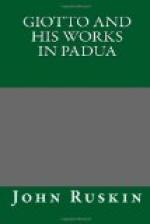I am certain that this is the estimate of his character which must be arrived at by an attentive study of his works, and of the few data which remain respecting his life; but I shall not here endeavour to give proof of its truth, because I believe the subject has been exhaustively treated by Rumohr and Foerster, whose essays on the works and character of Giotto will doubtless be translated into English, as the interest of the English public in mediaeval art increases. I shall therefore here only endeavour briefly to sketch the relation which Giotto held to the artists who preceded and followed him, a relation still imperfectly understood; and then, as briefly, to indicate the general course of his labours in Italy, as far as may be necessary for understanding the value of the series in the Arena Chapel.
The art of Europe, between the fifth and thirteenth centuries, divides itself essentially into great branches, one springing from, the other grafted on, the old Roman stock. The first is the Roman art itself, prolonged in a languid and degraded condition, and becoming at last a mere formal system, centered at the feet of Eastern empire, and thence generally called Byzantine. The other is the barbarous and incipient art of the Gothic nations, more or less coloured by Roman or Byzantine influence, and gradually increasing in life and power.
Generally speaking, the Byzantine art, although manifesting itself only in perpetual repetitions, becoming every day more cold and formal, yet preserved reminiscences of design originally noble, and traditions of execution originally perfect.
Generally speaking, the Gothic art, although becoming every day more powerful, presented the most ludicrous experiments of infantile imagination, and the most rude efforts of untaught manipulation.
Hence, if any superior mind arose in Byzantine art, it had before it models which suggested or recorded a perfection they did not themselves possess; and the superiority of the individual mind would probably be shown in a more sincere and living treatment of the subjects ordained for repetition by the canons of the schools.
In the art of the Goth, the choice of subject was unlimited, and the style of design so remote from all perfection, as not always even to point out clearly the direction in which advance could be made. The strongest minds which appear in that art are therefore generally manifested by redundance of imagination, and sudden refinement of touch, whether of pencil or chisel, together with unexpected starts of effort or flashes of knowledge in accidental directions, gradually forming various national styles.




